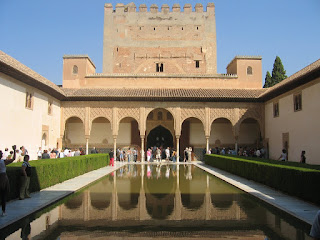Monday September 17 at Barcelona
Very long trip total hours door to door 32 hours. Slept the leg from Singapore to London, but still very tired.
Luggage made it from Melb to Barcelona, but not on carousel upon arrival. Interesting process - the handling is outsourced to another company, and you must pay to collect. No instructions or directions anywhere, so found our bags by trial and error.
Barcelona is full of tourists by the thousands - play find a local!! It has a very happy environment, with everyone obviously on holiday. All shapes and sizes and obviously a diverse range of countries, and very few seem to speak English.
Lost optical sunglasses at the airport (negligence due to exhaustion), but fortunately found them again.
Our hotel is on La Rambla, a wide street with a centre promenade, renowned for human "statues", stalls, restaurants, and entertainment. Great fun to walk along and peep at the people. Took the tourist bus today around the North of the city - good thing to do on the first day in a new city to get a feel for what is important to go back and explore. At 9.30 am it was easy to buy a ticket and hop on the bus, but on our return at 12.00 the queue was 1 km long! Obviously the time to do things is in the morning when everyone is still recovering from last night!
Our observations from the open air bus was of thousands upon thousands of multi-story apartment blocks, many very old but renovated and a good standard.
It seems that the information we had been given is correct - to find a restaurant open for dinner before 8.00 pm is etremely difficult if not impossible. So if you wish to eat earlier it must be "tapas" - small serves of various different entree style foods eg sausage meats, omelette, fried aubergine, mushrooms, shashlik, etc.
There are 8 universities in Barcelona, and 100,000 people fit into the football stadium.
There are bicycles for hire on racks around the city. Apparently you pay for 1 month, and then can ride anywhere and leave it anywhere in the city in one of the special racks which give access to the lock with a dedicated card. Very good idea.
Traffic is hectic, but buses and taxis have special lanes so it is easy to get around. There is a widely available network of bicycle lanes on the inside next to a central garden or walkway on the major routes around the city, which makes cycling very safe.
Seafood seems to be excellent - we will try some for dinner this evening.
There is much to see and do, and only two more days here before we catch the train to Valencia.
People do not seem to queue as readily as we are accustomed in Australia - they push in from the side or pretend there is no queue at all. Sometimes one must take a ticket with a number, but there is no sign or indication that this is required eg at the railway station.
Having fun. Weather warm an balmy, and hot in the sun during the middle hours of the day. About 28 degrees today.



